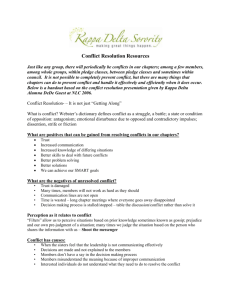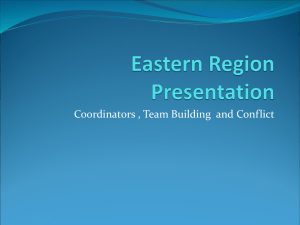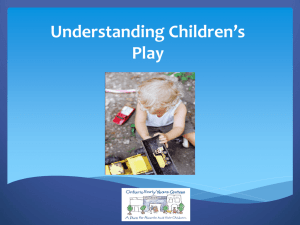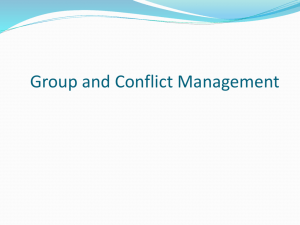power
advertisement
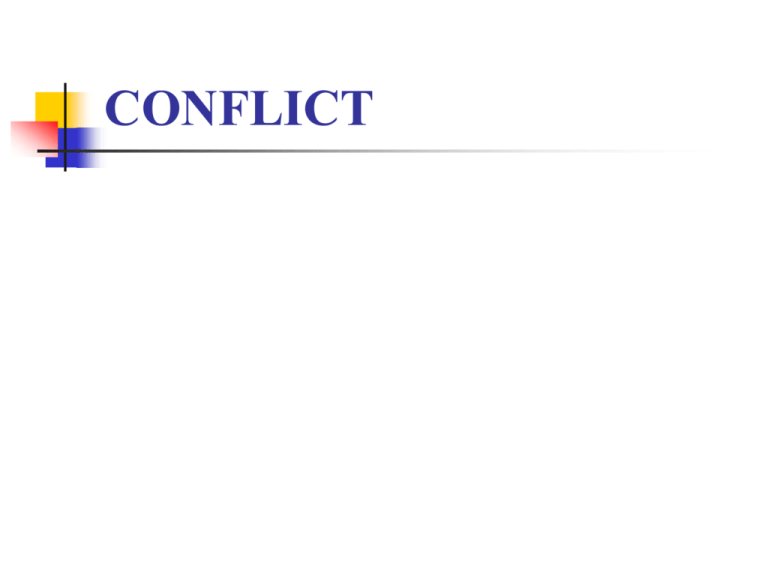
CONFLICT Popular Views of Conflict Conflict is destructive and should be avoided. Conflict is a sign of a poor relationship. Relational View of Conflict Conflict is inevitable and should be managed in ways that maintain the relationship. The Definition: A disagreement between/among connected individuals Expressed Struggle over: Perceived Incompatible Goals Perceived Limited Resources Interference __________________________________ Manifest and Latent Content and Relational Three aspects of conflict development contribute to conflict getting out of control. Once conflicts start, they tend to perpetuate themselves, especially if there are already problems between the people involved; When conflicts are over, our relationships change in some way, but we often do not recognize that it is how we manage the conflict that is critical to how it will affect our relationship. We do not recognize that manifest conflict actually serves many positive functions in our lives. Negative and Positive Effects Negative: leads to increased negative feelings Positive: forces people to examine problems causing conflict and to look for solutions Conflict Styles Competing / Aggressive: I win, you lose Avoiding / Withdrawing: I lose, you lose Accommodating: I lose, you win Compromising: I win and lose, you win and lose Collaborating / Assertive / ProblemSolving: I win, you win Constructive Process The management of conflicts is constructive if the conflict is defined as a mutual problem, and it is defined as a "win-win" situation where both parties gain. Participants must express their ideas openly and honestly, and all parties must be viewed as equal--with their positions taken seriously, valued, and respected. Participants use effective communication skills, such as responsive listening and perception checking, so that differences in opinions can be clarified and understood. Participants express their assumptions and perspectives on the problem and do not take disagreements as rejection. Destructive Process The conflict is not defined as a mutual problem: it is a "win-lose" situation where one person gains and the other loses. Participants are not open or are deceitful and they do not view each other as equal or respect others' ideas. Participants do not use effective communication skills, and differences in opinions are suppressed or ignored. Participants do not clarify their assumptions or perspectives on the problem and they take disagreements as rejection. Constructive Outcomes Participants feel understood and think they influenced others. They are committed to the solution and are satisfied with the decision. They feel accepted by the other person. Their ability to manage future conflicts is increased. Destructive Outcomes Participants do not feel understood and think they had little influence on others. They are not committed to the solution and are not satisfied with the solution. They do not feel accepted by the other person. Their ability to manage future conflicts is decreased. Overall: Be rational Be understanding Communicate Be reliable Use noncoercive modes of influence Be accepting Negotiating solutions We can try to change others We can try to alter the conditions underlying the conflict We can change our own behavior Separate the People from the Problem Separate the relationship from the substance. Be hard on the problem, soft on people Focus on Interests, Not Positions Reconcile interests, not positions Behind opposed positions lie shared and compatible interests, as well as conflicting ones Acknowledge their interests as part of the problem How do you identify interests? Ask “Why?” (put yourself in their shoes) Ask “Why not?” (think about their choice) Realize that each side has multiple interests. Invent Options for Mutual Gain Separate inventing from deciding Broaden your options Look for mutual gain Insist on Using Objective Criteria Fair standards Fair procedures Deliberate deception Misrepresentation about facts, authority, or intentions Phony facts Ambiguous authority Dubious intentions Psychological warfare Stressful situation (physical setting) Personal attacks The good-guy/bad-guy routine Threats Positional pressure tactics Refusal to negotiate Extreme demands Escalating demands A calculated delay “Take it or leave it.” POWER and INFLUENCE Types of Influence Rational Persuasion Manipulative Persuasion Inducement Power Rational Persuasion By using truthful information and cogent reasoning Manipulative Persuasion By omitting, distorting, or falsifying information and/or using fallacious reasoning Inducement By promising rewards POWER Power is the ability of one person to get another person to act in accordance with the first person’s intentions. Although this can be accomplished through other methods, power implies the ability/capacity to enforce one’s wishes on other people Some people are more powerful than others. People are Equal in principle (under the law, in moral terms, etc.) … but different in abilities, strengths, wealth, etc. The sources of power Knowledge, expertise, social/professional position, money, contacts Credibility (if you were correct several times, you will be believed; in coercion – your threats will be taken seriously The “rules” of power Some people are more Machiavellian than others. Power can be increased or decreased. Power Follows the principle of Less Interest (is relative) Power has a cultural dimension – power distance. Power is frequently used unfairly. Sexual harassment “Bothering someone in a sexual way” “Unwanted sexual advances” “Request for sexual favors in exchange for a job promotion etc.” COMMUNICATING POWER Speaking Power Avoid hesitation – uncertainty Avoid too many intensifiers (exaggeration) Avoid disqualifiers – lack of competence. But also truthfulness. Avoid self-critical statements. “I am not very good at…” Avoid slang, vulgar expressions. COMMUNICATING POWER Nonverbal power Use consistent packaging – do not contradict yourself! (verbal – nonverbal consistency) Maintain eye contact! Avoid vocalized pauses! Avoid speaking too much and too fast. Empowering others Helping others to gain increased power. Share decision making. Be willing to relinquish control and allow the other person the freedom to make decisions. Be constructively critical Encourage growth. Be supportive, open, etc.
